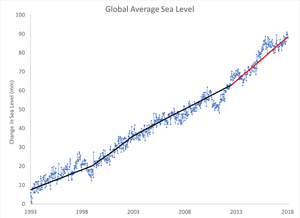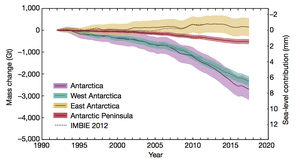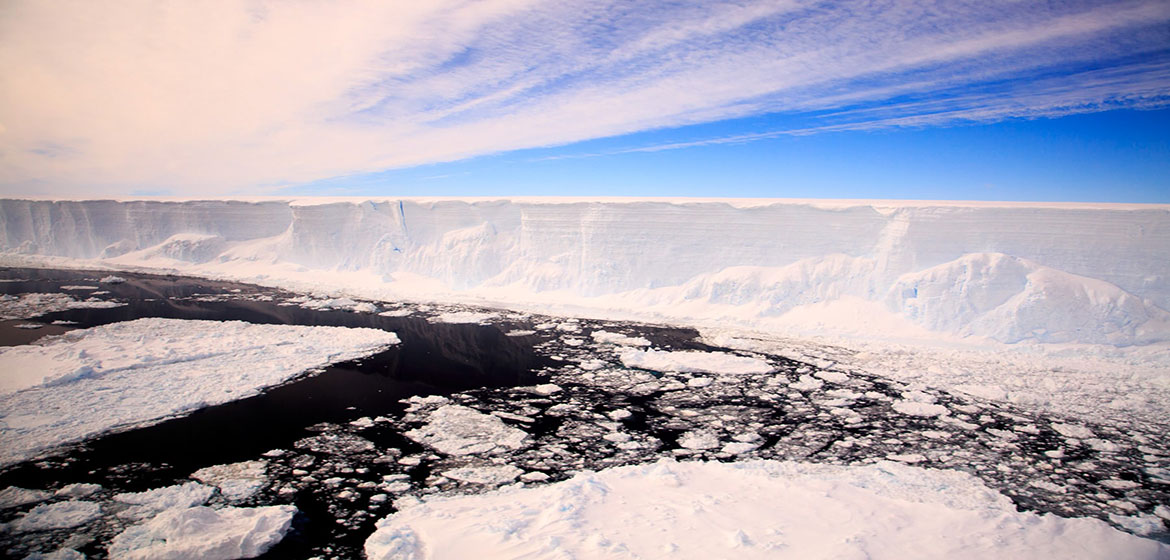Short answer: maybe
By Dana Nuccitelli
There’s recently been a spate of in the , but in reality, and melting ice is playing an increasingly large role. In the first half of the 20th Century, average global sea level rose by about 1.4 millimeters per year (mm/yr). Since 1993, that rate has more than doubled to 3.2 mm/yr. And since 2012, it’s jumped to 4.5 mm/yr.

Thermal expansion (ocean water expanding as it warms) continues to play the biggest role in sea level rise, but its contribution of about 1.3 mm/yr is now responsible for a smaller proportion of total sea level rise (30% in recent years) than its contribution since the 1990s (40% of the total). That’s because of the acceleration in melting ice.
, recently contributing about 0.75 mm/yr to sea level rise, up from 0.65 mm/yr since the 1990s. But the biggest jumps have come from ice in Greenland and Antarctica. Greenland had been responsible for about 0.48 mm/yr sea level rise since 1990, but in recent years is up to 0.78 mm/yr. found that Greenland contributed about 5% to sea level rise in 1993 and 25% in 2014.
Antarctica is a huge question mark with warning signs
using found that from about 0.2 mm/yr since the 1990s to 0.6 mm/yr since 2012, during which time global sea level rise also spiked. Accelerated ice melt from Antarctica, Greenland, and glaciers have all played a role in the faster recent sea level rise. The question is whether it’s a temporary jump, or if we need to worry about a continued acceleration in Antarctic ice loss.
Another recent found that rapid losses from Antarctic ice are plausible. The study found that in moderate to high carbon-emission scenarios, an average expected sea level rise of 2 to 2.5 feet by 2100 could actually become 3 to 5 feet once Antarctic ice sheet dynamics are taken into account.
The vast majority of Antarctica’s current ice loss is coming from West Antarctica, where . In East Antarctica, , only about 35% of the glaciers are below sea level. , which is particularly problematic for that low-lying ice in West Antarctica. Research suggests that the .

Should we be worried?
Short-term variations in sea level rise do happen. due to a strong La Niña cycle, which typically results in an increase of rain and snow falling over land. This resulted in a number of epic deluges and flooding across the globe; more water on land temporarily meant less in the ocean.
However, Antarctica and Greenland could potentially cause rapid sea level rise. As James Hansen explains in the video below, there have been periods in the not-so-distant past when sea levels rose at an average rate of 1 meter every 20 years.
In past eras when temperatures and atmospheric carbon dioxide levels were similar to those today and to , like in and , sea levels were about 20 to 80 feet higher. Unless we manage to actually cool global temperatures, we’re certainly due for significantly more sea level rise. The large ice sheets on Greenland and Antarctica will continue to melt for as long as 1,000 years. That’s why sea levels were so much higher in past eras whose climates remained at hot temperatures like today’s for thousands of years.
It takes time for ice to melt. The question is, how fast will it happen? rise unquestionably poses a long-term threat, but how much of a short-term threat largely depends on just how stable the Antarctic ice sheet turns out to be. The recent acceleration of Antarctic ice loss, while not yet definitive, is certainly cause for concern.
Source:
Related to SDG 13: Climate action



